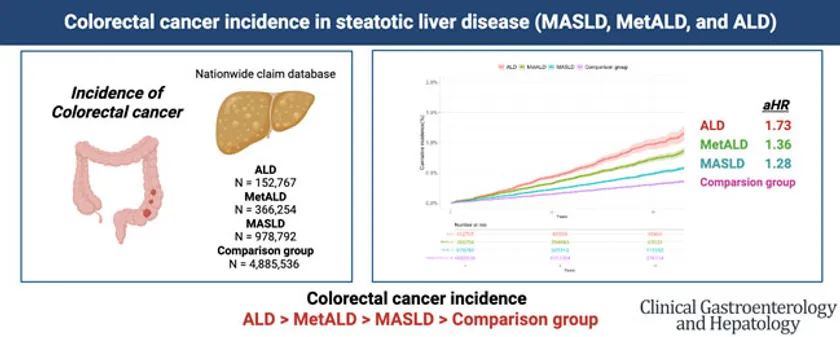International Collaborative Study on Colorectal Cancer Risk in Steatotic Liver Disease Published in Clinical Gastroenterology and Hepatology
国立大学法人信州大学
Shinshu University is pleased to announce that the results of an international collaborative study on colorectal cancer risk in steatotic liver disease have been published in Clinical Gastroenterology and Hepatology.
Key Findings
The prevalence of steatotic liver disease (SLD) in Japan is estimated to be 20?30%, primarily caused by metabolic abnormalities associated with alcohol consumption and metabolic syndrome.
Compared to individuals without liver disease, patients with alcohol-associated liver disease (ALD) had the highest risk of colorectal cancer, with a 1.73-fold increased risk compared to the control group.
Patients with metabolic dysfunction-associated SLD and increased alcohol intake (MetALD) had a 1.36-fold increased risk, while those with metabolic dysfunction-associated SLD (MASLD) had a 1.28-fold increased risk.
This study was an international collaboration between Shinshu University, Musashino Red Cross Hospital, and the University of California, San Diego (UCSD).
Study Summary
SLD was reclassified following international recommendations in 2023, leading to a revision of the traditional concept of non-alcoholic fatty liver disease (NAFLD). The updated classification defines the following subtypes:
ALD: SLD due to excessive alcohol consumption.
MetALD: SLD caused by moderate alcohol intake combined with metabolic abnormalities.
MASLD: SLD primarily caused by metabolic abnormalities.
SLD is not only a risk factor for cirrhosis and hepatocellular carcinoma but also contributes to cardiovascular diseases such as myocardial infarction and stroke, as well as the development of extrahepatic malignancies.
In this study, the risk of colorectal cancer across different SLD subtypes was evaluated using a nationwide cohort of 6.38 million individuals, classified according to the revised SLD criteria. The analysis was conducted using liver disease-free group as the reference, and the adjusted hazard ratio (aHR) was calculated to quantify the increased risk of colorectal cancer after adjusting for confounding factors such as age, gender, lifestyle, and diabetes mellitus.
Main Results
The risk of developing colorectal cancer was 1.73 times higher in patients with ALD compared to controls.
The risk in patients with MetALD and MASLD was 1.36-fold and 1.28-fold higher, respectively.

Colorectal Cancer Incidence in Steatotic Liver Disease
Future Prospects.
Enhancing colorectal cancer screening programs for SLD patients, particularly those with ALD who consume excessive alcohol, is of critical importance. Additionally, efforts should be directed toward establishing preventive measures for patients with MetALD and MASLD. The broader adoption of the SLD classification will play a key role in advancing a global cancer prevention strategy.
Authors and Affiliations
This study was conducted by the following researchers:
Authors:
Takefumi Kimura, MD, PhD (1)
Nobuharu Tamaki, MD, PhD (2)
Shun-Ichi Wakabayashi, MD, PhD (1)
Naoki Tanaka, MD, PhD (3, 4, 5)
Takeji Umemura, MD, PhD (1)
Namiki Izumi, MD, PhD (2)
Rohit Loomba, MD, MHSc (6)
Masayuki Kurosaki, MD, PhD (2)
Affiliations:
1.Division of Gastroenterology, Department of Medicine, Shinshu University School of Medicine, Nagano, Japan
2.Department of Gastroenterology and Hepatology, Musashino Red Cross Hospital, Tokyo, Japan
3.Department of Global Medical Research Promotion, Shinshu University Graduate School of Medicine, Matsumoto, Japan
4.International Relations Office, Shinshu University School of Medicine, Matsumoto, Japan
5.Research Center for Social Systems, Shinshu University, Matsumoto, Japan
6.MASLD Research Center, Division of Gastroenterology and Hepatology, Department of Medicine, University of California, San Diego, La Jolla, USA
Title of the article and the journal in which it was published
Title: Colorectal Cancer Incidence in Steatotic Liver Disease
(MASLD, MetALD, and ALD)
Journal : Clinical Gastroenterology and Hepatology
DOI : 10.1016/j.cgh.2024.12.018
- Category:
- Research & Reports

